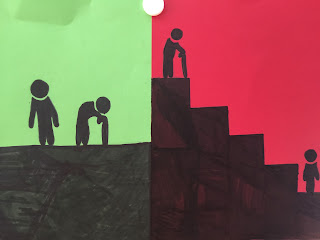Monday, 30 May 2016
Grade Six Reflection
After a whirlwind year of learning and fun, it's time for Grade Six to reflect ahead of Graduation tomorrow. Thank you for reflecting thoughtfully!
Sunday, 29 May 2016
6A Last day of PE, rainy day, Just Dance!
Wednesday, 25 May 2016
Tuesday, 24 May 2016
Grade Six Compare Cultures
What fun we have had preparing for Global Mindedness Day! Here are some of the culture boxes and comparisons that the Grade Six students have prepared.
Thoughts on what it means to be internationally minded:
To be internationally minded means to connect and to share different traditions and ideas about culture, also to accept other people's thinking even though it could be different to yours. (Ashlynn, Lei, Rachel, Reina)
To be internationally minded is to be open to different religions and cultures, and not discriminate against them or treat them differently. (Emma, Maria, Miki, Natsu)
International Mindedness is to accept and be aware of others' cultures, ideas and beliefs by respecting and empathising with others. (Alice, Mia, Seoyoon, Sunny)
International mindedness means having a global perspective on different cultures and beliefs. (Catherine, Nana, Maiya, Siyeong)
Everyone has their own beliefs and their own mind. They should look into other cultures and get interested to be more open-minded and to be internationally minded. (Leon, Victoria, Emilie, Kyu Mi, Yuna)
Monday, 9 May 2016
Exploring our Cultures.
We have just finished our exhibition. What a gut-wrenching yet exhilarating experience it has been. As always, it all came together when the students started presenting to an audience. The climax for us grade 6 teachers happened when we watched our students navigate the tough questions (with an air of aplomb, may we add) that were thrown their way! And it was with the ebbing remnants of adrenaline that we approached our final unit in grade 6 which is about Cultures around the world.
Students were asked to bring in artifacts from their homes. This is a tried and tested way of starting a unit such as this one!
In order to notch up the challenge a bit, we introduced the iceberg metaphor on culture.
These artifacts were then shared with the whole class. The iceberg helped the students make deeper associations with the concept of culture. As the unit progresses, it will be interesting to see if the students can come up with another interesting metaphor.
 |
| Hye won demonstrates how a Korean lady sits. |
 |
| Our artifact museum is slowly growing. |

Neema spoke of the concept of beauty using the iceberg metaphor to guide her. This was a great moment of learning for all of us! The Japanese concept of beauty was to whiten their faces and blackened the teeth. The woman is holding a red umbrella. The African concept of beauty was of a woman holding a baby. This is reinforced in the saying on the piece of cloth ( a Kanga) with a proverb, proclaiming the same thing! What a wonderful contribution to our class discussion.
A short clip where Hana explains the tea ceremony...
We integrated this unit with language by looking at different traditional tales of Cinderella.
Comparing two cultures using a clock organiser we got from this website.
We thought about how best we could compare cultures. The students had used Venn diagrams, matrices, and T-charts and were not keen on using them again.
So I showed them some poster made by Yang Liu and then asked the girls to create their own.
This activity engaged them as they were forced to think in terms of simple symbols and had to choose their colours carefully.
Take a look at what some of them came up with:
 |
| This one is an example of Yang Liu's poster compare the Chinese and German culture. |
Our Culture boxes
The summative task for language is pretty cool! We'd like the students to come up with their own version of Cinderella. Though there is a very ancient Japanese one, not many are familiar with it. It would be great to see the students create their own story using the intricate concept of culture.
Probability in Grade 6
The 50-50-90 rule: Anytime you have a 50-50 chance of getting something right, there's a 90% probability you'll get it wrong.
-Andy Rooney
However long I have taught, these classroom conversations never cease to amaze me!
-Andy Rooney
However long I have taught, these classroom conversations never cease to amaze me!
Tuesday, 3 May 2016
Grade 6 students were glad to take a brain break during their final DRA assessments! Thank you to the PE department for these videos.
Subscribe to:
Comments (Atom)

































